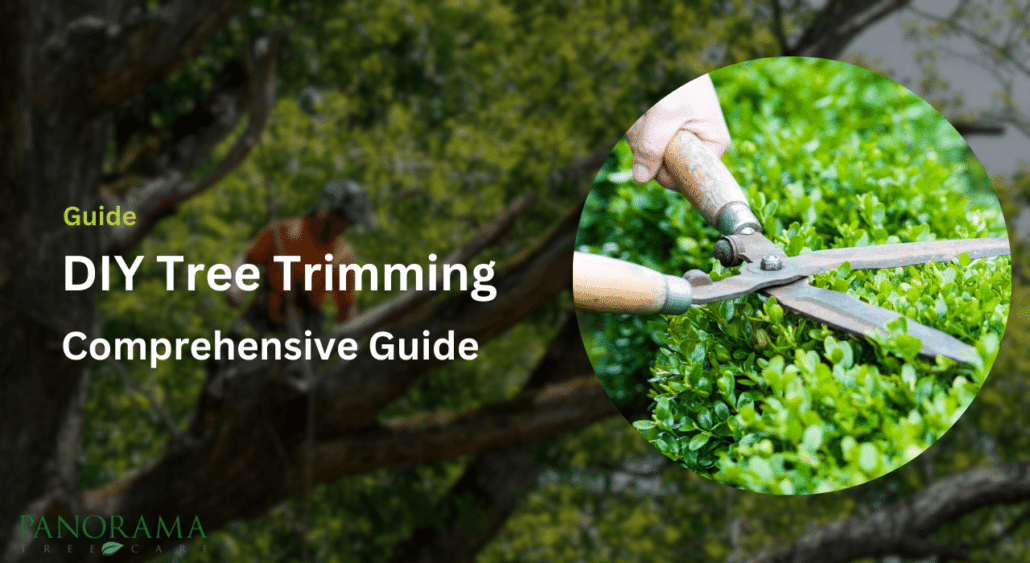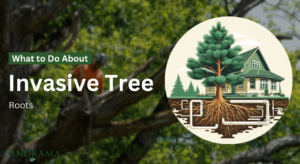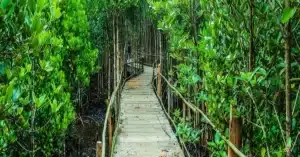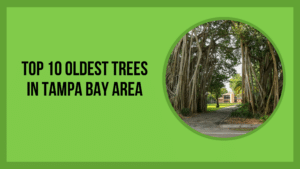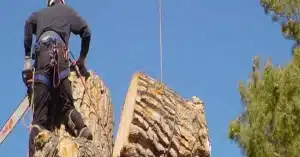Trees are an essential part of any landscape, providing beauty, shade, and environmental benefits.
However, to maintain their health and appearance, regular pruning is necessary.
While hiring a professional arborist is always an option, many homeowners choose to take on the task of DIY tree trimming.
It can be a cost-effective and satisfying endeavor, but it also requires proper knowledge and techniques to ensure safety and maintain the tree’s well-being.
Importance of Tree Trimming
Tree trimming isn’t just about aesthetics; it’s about the health and safety of your trees and property.
Regular trimming promotes healthy growth, reduces the risk of falling branches, and enhances the overall appearance of your landscape.
Neglecting tree trimming can lead to overgrowth, disease, and potential hazards.
Benefits of DIY Tree Trimming
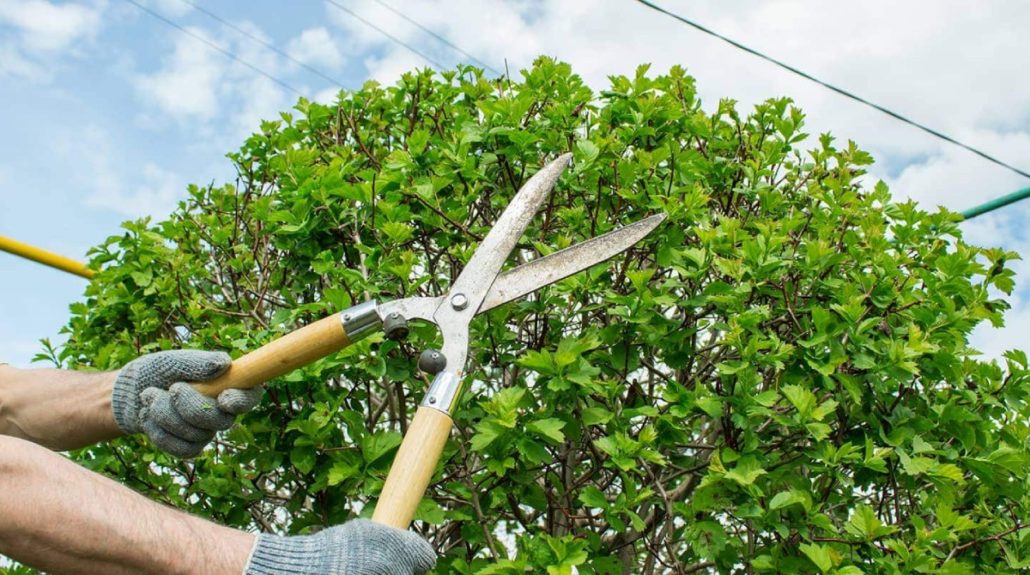
Cost Savings
One of the primary advantages of DIY tree trimming is the potential for significant cost savings. Hiring professional arborists can be expensive, especially for routine maintenance tasks like tree trimming.
By taking on the task yourself, you eliminate the need to pay for labor and can save money that would otherwise be spent on service fees.
Personal Satisfaction
DIY tree trimming can provide a sense of accomplishment and pride in caring for your landscape.
There’s a unique satisfaction in personally tending to the health and appearance of your trees, knowing that your efforts directly contribute to their well-being.
It fosters a deeper connection to your property and surroundings, enhancing your overall enjoyment of your outdoor space.
Flexibility and Control
When you trim your own trees, you have full control over the process and can tailor it to suit your specific preferences and needs.
You can choose which branches to prune, how much to trim, and the overall shape and appearance you want to achieve.
This level of flexibility allows you to maintain the aesthetic integrity of your landscape according to your vision.
Learning Opportunity
DIY tree trimming provides an opportunity to learn more about arboriculture and tree care practices.
Engaging in hands-on experience allows you to familiarize yourself with different tree species, pruning techniques, and the signs of common tree problems.
This knowledge can empower you to better understand and care for your trees in the long run.
Immediate Action
When you notice a problem with your trees, such as dead or overgrown branches, DIY tree trimming allows you to take immediate action without having to wait for a professional service appointment.
Prompt pruning can help address issues early on, preventing them from worsening and potentially saving your trees from further damage or decline.
Customization
DIY tree trimming enables you to customize the pruning process to meet the specific needs of your trees and landscape.
You can prioritize certain areas for trimming, address specific concerns, and adapt your approach based on the unique characteristics of each tree.
This customization ensures that your trees receive personalized care tailored to their individual requirements.
When to Consider Hiring a Professional Arborist
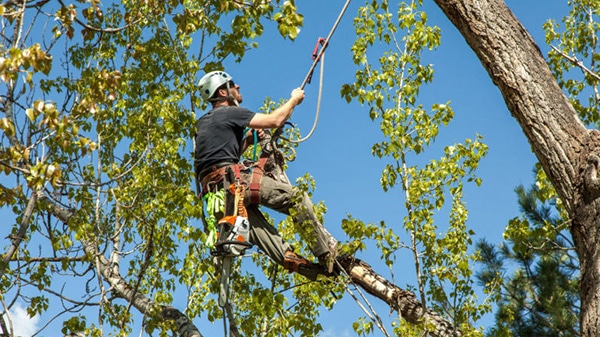
Large or Hazardous Trees
Trees that are particularly large or pose hazards due to their location or condition may require specialized skills and equipment to trim safely.
Large trees often have heavy branches that can pose risks of injury or property damage if not handled properly.
Professional arborists are trained to assess the risks associated with large trees and can safely navigate the challenges of trimming them. So, it’s always recommended hiring a tree trimming experts like us.
If you’re unsure whether to tackle the job yourself, consult with Tampa tree trimming professionals who can assess the risks and ensure your trees get the best care with zero guesswork.
Trees Near Power Lines or Structures
Trees growing in close proximity to power lines, buildings, or other structures present unique challenges for trimming.
The proximity of these obstructions increases the risk of accidents and requires careful planning and execution to avoid damage.
Professional arborists are trained to work around obstacles safely and can employ techniques such as directional pruning to minimize risks.
Extensive Pruning Needs
Trees that require extensive pruning, such as those with significant overgrowth or structural issues, may be best handled by professionals.
Extensive pruning often involves intricate cuts and strategic shaping to achieve desired results without compromising the tree’s health or stability.
Professional arborists have the expertise to assess the pruning needs of trees and implement appropriate techniques to achieve optimal outcomes.
Specialized Equipment Requirements
Some tree trimming tasks may require specialized equipment that is not readily available to the average homeowner.
Equipment such as aerial lifts, chainsaws, and safety harnesses are essential for safely accessing and trimming trees at height.
Professional arborists are equipped with the necessary tools and gear to perform tree trimming safely and efficiently.
Complex Situations or Unique Circumstances
Certain tree trimming situations may be complex or involve unique circumstances that require professional expertise.
For example, trees with structural defects, diseases, or pests may require careful assessment and targeted treatment by arborists.
Additionally, trees in urban environments or conservation areas may be subject to regulations and restrictions that require professional guidance for compliance.
Before You Start: Safety First
Before diving into tree trimming, prioritize safety. Wear appropriate personal protective equipment, such as safety glasses, gloves, and sturdy shoes, to protect yourself from potential hazards.
Assess the work area for overhead power lines and nearby structures, and take necessary precautions to avoid accidents.
Clear the area of obstacles and create a safe working environment.
Essential Tools for DIY Tree Trimming
Hand Pruners and Loppers
Hand pruners, also known as pruning shears or secateurs, are essential tools for trimming small branches and twigs up to about 1 inch in diameter.
They come in bypass and anvil designs, with bypass pruners being ideal for clean cuts on living branches.
Loppers are similar to pruners but have long handles for increased leverage, making them suitable for cutting thicker branches up to 2 inches in diameter.
Pole Pruners and Saws
For branches that are out of reach from the ground, pole pruners and saws are indispensable tools.
Pole pruners consist of a long pole with a cutting head at the end, allowing you to reach branches high above without the need for a ladder.
They typically feature a bypass cutting mechanism similar to hand pruners. Pole saws, on the other hand, are equipped with a saw blade at the end of a pole, enabling you to cut thicker branches that are beyond the reach of traditional pruners.
Ladder or Lift Equipment
When trimming tall trees, especially those with branches located high above the ground, a ladder or lift equipment may be necessary to safely access elevated branches.
Extension ladders are commonly used for tree trimming tasks, providing stability and support while working at heights.
Alternatively, if the tree is exceptionally tall or inaccessible with a ladder, lift equipment such as cherry pickers or bucket trucks may be required to safely reach and trim branches at height.
Maintenance and Sharpening Tools
To ensure the effectiveness of your trimming tools and achieve clean cuts, it’s crucial to regularly maintain and sharpen them.
Invest in a sharpening tool, such as a sharpening stone or file, to keep the blades of your pruners, loppers, and saws sharp and in optimal condition.
Additionally, inspect your tools regularly for any signs of damage or wear, and replace any worn or damaged parts as needed to maintain their functionality and safety.
Pruning Techniques and Best Practices
Understanding the Branch Collar and Branch Bark Ridge
The branch collar is the swollen area where a branch meets the trunk of the tree, while the branch bark ridge is the raised ridge of bark where the branch meets the trunk.
These are crucial areas where the tree forms protective barriers to seal off wounds and promote healing.
When making pruning cuts, it’s important to preserve the branch collar and branch bark ridge to minimize damage and allow the tree to heal properly.
Choosing the Appropriate Pruning Cuts
Different pruning cuts serve different purposes, depending on the needs of the tree and the desired outcome.
Thinning cuts involve selectively removing branches to improve air circulation and light penetration throughout the canopy.
Raising cuts involve removing lower branches to provide clearance for pedestrians, vehicles, or structures. Reducing cuts involve shortening branches to maintain the tree’s shape and size.
By choosing the appropriate pruning cuts for the task at hand, you can achieve the desired results while promoting the overall health and structure of the tree.
Avoiding Topping or Stubbing
Topping, also known as stubbing, is the practice of indiscriminately cutting back large portions of the tree’s canopy, often leaving behind stubs or truncated branches.
This practice is highly detrimental to the health and integrity of the tree, as it results in weak, poorly attached regrowth that is susceptible to disease, pests, and structural failure.
Instead of topping, focus on selective pruning to maintain the tree’s natural form and structure while promoting healthy growth and vitality.
Timing of Pruning
The timing of pruning plays a crucial role in the tree’s response to the pruning cuts and its ability to heal effectively.
For most trees, pruning during the dormant season, typically in late winter or early spring, is recommended.
Pruning during this time minimizes stress on the tree and allows wounds to heal more quickly.
It’s important to research the specific pruning requirements of the tree species in question and prune accordingly to maximize the benefits and minimize the risks.
Cleanup and Disposal
Proper cleanup and disposal of pruned branches and debris are essential to maintain a tidy and safe landscape.
Safely remove pruned branches and debris from the area to prevent tripping hazards and property damage.
Consider recycling or composting organic material whenever possible. Protect the surrounding area by minimizing impact and restoring disturbed areas to their original condition.
Don’ts of DIY Tree Trimming
Don’t Prune Too Much at Once
One common mistake in DIY tree trimming is pruning too aggressively or removing too many branches at once.
This can stress the tree and disrupt its natural growth patterns. Overpruning can lead to excessive growth in response to the pruning stress or cause the tree to decline due to the loss of too much foliage.
It’s important to practice moderation and only remove as much as necessary to achieve your trimming goals without compromising the tree’s health.
Use Proper Tools and Techniques
Using improper tools or techniques can result in damage to both the tree and yourself. Avoid using dull or damaged tools, as they can cause jagged cuts that are more difficult for the tree to heal.
Additionally, using incorrect cutting techniques, such as making cuts too close to the trunk or leaving stubs behind, can lead to decay and disease.
Invest in high-quality pruning tools and educate yourself on proper pruning techniques to ensure safe and effective tree trimming.
Never Ignore Safety Precautions
Safety should always be a top priority when trimming trees, especially when working at heights or near power lines. Ignoring safety precautions can result in serious injuries or accidents.
Always wear appropriate personal protective equipment, such as gloves, safety glasses, and sturdy footwear, to protect yourself from potential hazards.
Use caution when climbing ladders or using lift equipment, and be mindful of your surroundings to avoid accidents.
Avoid Pruning During Extreme Weather Conditions
Pruning trees during extreme weather conditions, such as high winds, heavy rain, or extreme temperatures, can compromise safety and the health of the tree.
Strong winds can make tree branches unpredictable and increase the risk of accidents.
Heavy rain can make branches slippery and difficult to handle, while extreme temperatures can stress the tree and impede healing. It’s best to wait for calm, mild weather conditions to ensure safe and effective tree trimming.
Don’t Neglect Follow-Up Care and Maintenance
After completing tree trimming, it’s essential to follow up with proper care and maintenance to ensure the long-term health of your trees.
This includes watering, fertilizing, and monitoring the tree for signs of stress or disease. Regular follow-up care will help promote healthy growth and recovery after pruning, ensuring that your trees remain vibrant and resilient in the years to come.
Maintaining Your Trees’ Health
Tree trimming is just one aspect of maintaining your trees’ health. Keep an eye out for pests and diseases, and take prompt action to address any issues that arise.
Proper watering and fertilization are essential for promoting healthy growth and resilience against stressors.
Establish a regular pruning and maintenance schedule to keep your trees in optimal condition year-round.
Conclusion
DIY tree trimming can be a rewarding and cost-effective endeavor for homeowners, but it requires proper knowledge, techniques, and safety precautions.
By following the dos and don’ts outlined in this guide, you can effectively prune and maintain your trees, keeping your landscape healthy and beautiful.
However, don’t hesitate to seek professional help when faced with challenging or potentially hazardous situations.
For larger trees or those in hard-to-reach areas, it’s best to call in the experts. Our reliable tree trimming services Tampa ensure safe, efficient, and expert-level care every time.
With responsible DIY tree trimming and ongoing care, your trees will continue to thrive and enhance your outdoor living spaces for years to come.
Need help with tree trimming or unsure where to start? Contact us today for expert advice or to schedule a service with our certified team in Tampa Bay.

